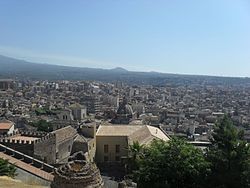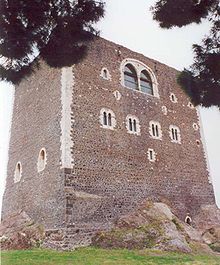Paternò
You can help expand this article with text translated from the corresponding article in Italian. (December 2023) Click [show] for important translation instructions.
|
Paternò | |
|---|---|
| Città di Paternò | |
 | |
 Paternò within the Province of Catania | |
| Coordinates: 37°34′N 14°54′E / 37.567°N 14.900°E | |
| Country | Italy |
| Region | Sicily |
| Metropolitan city | Catania (CT) |
| Frazioni | Sferro |
| Government | |
| • Mayor | Nino Naso |
| Area | |
| • Total | 144.04 km2 (55.61 sq mi) |
| Elevation | 225 m (738 ft) |
| Population | |
| • Total | 48,009 |
| • Density | 330/km2 (860/sq mi) |
| Demonym(s) | Paternesi, Patornesi |
| Time zone | UTC+1 (CET) |
| • Summer (DST) | UTC+2 (CEST) |
| Postal code | 95047 |
| Dialing code | 095 |
| Patron saint | Santa Barbara and San Vincenzo Martyr |
| Saint day | December 4 |
| Website | Official website |


Paternò (Sicilian: Patennò) is a comune (municipality) in the Metropolitan City of Catania, in the Italian region of Sicily. With a population (2016) of 48,009,[2] it is the third municipality of the province after Catania and Acireale.
Geography
Paternò borders with the municipalities of Belpasso, Biancavilla, Catenanuova (EN), Centuripe (EN), Ragalna, Ramacca and Santa Maria di Licodia.[4] Its only hamlet (frazione) is the village of Sferro.[5]
Within Paterno there is a geologic feature named 'Salinelle', a place where small mud volcanoes emerge from cracks in the ground.[6] This area in which the Salinelle surfaces includes an archeological site currently uncovering evidence of Roman baths previously built on and thought to have used the Salinelle mud.
History
The site of Paternò was settled before 3500 BC. Its inhabitants were probably the Sicani, although it was located in mainly Sicel territory. The modern name derives form the Greek Paeter Aitnaion, meaning the "Fortress of the Etnaeans".
Ancient historians refer to two contiguous or nearby cities of Sican origin: Hybla Gereatis and Inessa (later renamed Aetna). Most modern scholars regard the place called Castro as the site of Aetna, about 4 km northeast from Paternò, on a hill projecting from the foot of the mountain.[7]
It was a centre of medium importance in the Greek and Roman eras.
Hybla and Inessa fell into Greek hands around 460 BC, when they were besieged by the Syracusans led by the tyrant Hieron I and the two centres were thus Hellenised.[8] They were also involved in the wars between the Syracusans and the Athenians and devastated by the latter, and later again by the former in 403 BC when Dionysius I of Syracuse came to power; in 396 BC he sent mercenaries to Aetna from Campania who carried out numerous massacres of the population for favouring the Athenians in 415 BC. Aetna and Hybla together with the other cities of eastern Sicily were liberated in 339 BC by the Corinthians led by general Timoleon.
The Greek "Silver of Paternò" treasure was found in 1909 and sold, but the majority is now in the Altesmuseum in Berlin.[9][10]
In 264 BC, the First Punic War broke out between the Carthaginians and the Romans and Aetna and Hybla sided with the former, but after their defeat the two villages fell inexorably under Roman domination. The Romans led by the consul Manius Otacilius Crassus entered Aetna around 243 BC and conquered 67 other Sicilian cities.
Sicily became a Roman province and suffered Roman tyranny and exploitation with the enslavement of its inhabitants. In 136 BC this led to the revolt led by Eunus and Cleone of Cilicia in the First Servile War. During this battle, Aetna served as a place of refuge for many rebels, but together with Hybla, it suffered the greatest damage at the end of the Second Servile War as agricultural and pastoral lands were damaged. The situation worsened further when Gaius Verres, praetor in Sicily in 73 BC, ordered extortion, robbery and violence of all kinds on the two towns, forcing them to deliver of 300 000 bushels of wheat and the payment of 50 000 sesterces.
Aetna and Hybla were included in the cities of civitates decumanae, liable to pay Rome the decuma tax of one tenth, and not enjoying the rights of other cities as they had been conquered after offering resistance. [11]
The longest aqueduct in Roman Sicily at 24 km length passed through the territory close to the city on its route to Catania.
It was largely depopulated in the three centuries before 1000 AD; during the subsequent Arab domination of Sicily, it was known as Batarnù. After the Norman conquest in the 1040s, they built the castle and founded the current city; it was renamed Paternionis and began a period of flourishing. It was here that King Frederick III of Sicily created the Camera Reginale ("Queen's Chamber") as a wedding gift for his wife Eleanor of Anjou, and this was inherited by the subsequent Queens of Sicily. This period of splendour for Paternò lasted until the 15th century, when it became a fief and in consequence slowly lost importance.
Historically, the area around Paternò was plagued by malaria, caused by the marshlands of the Plain of Catania. This has since long been remedied, and the urban development of the town enjoyed a large acceleration in the 1960s and 1970s.
The Paternò Treasure
The treasure was found by chance by a peasant woman in 1909 near the Norman fortress and consisted of 13 or more exquisite pieces.[12] The silverware was sold for little money to two dealers from Catania, who divided it so that most ended up in Naples and was bought by the Parisian merchants Cesare and Ercole Canessa. They had the silverware restored by Alfred André, and in 1911 in Paris they sold seven pieces to Robert Zahn, curator of the antiquarium of the Royal Museums of Berlin. In 1913 and 1914, the remaining six pieces came into the possession of the Antiquarium as a donation from the wealthy Berlin family Von Siemens who had bought them from Zahn himself. Zahn gave an date between the 4th and 3rd centuries BC and attributed the silver to a Taranto goldsmith stylistically. Between 1912 and 1915, Paolo Orsi (who did not fully understand the historico-archaeological importance of hill of Paternò) announced that, in addition to the silverware treasure, two coin treasures were found on the same hill: the first, partly lost, from the 5th century BC, the second of the Roman-Republican age.
Recently the shell-shaped pyx equipped with hinge and ring and decorated on the outside with an octopus has been attributed rather to Alexandrian-inspired artists of the 3rd century BC.[13]
Six of the vessels have inscriptions naming three or four different owners suggesting that the vessels came from Taranto but were acquired in Sicily during the 3rd century BC. The last owner may have been a Roman landlord who feared the ravages of Verres and might have hidden away his silver before 70 BC.
Transportation
Paternò is served by three state roads leading to Catania, Randazzo and Troina areas.
The train station was originally used mostly for food transportation, and is now out of service. The main passenger station is part of the narrow-gauge Ferrovia Circumetnea. The latter also provides a regular bus service to destination on the Catania-Adrano line.
Main sights
- Norman Castle, built in 1072 by order of Roger I of Sicily
- Santa Maria dell'Alto, Mother Church (Chiesa Madre) of the town, built in 1342 and largely modified in the early 18th century. It is connected by a scenic staircase to the Porta del Borgo.
- San Francesco alla Collina (1346), with a church in Gothic style and remains of Baroque decorations
- Rococo church of Cristo al Monte
- Santa Caterina d'Alessandria
- Santa Maria della Valle di Iosaphat, commissioned in 1072 by Adelaide del Vasto, with a Gothic portal
- Associazione Culturale Paternesi.com, a cultural association born in November 2002, from an idea of Giorgio Ciancitto, to take care of the city of Paternò around the world
- Sanctuary of the Madonna Santissima della Consolazione
- The Paternò Salinelle site


International relations
Twin towns — sister cities
Paternò is twinned with:
 Santa Barbara, US, since 1978
Santa Barbara, US, since 1978 Sesto Fiorentino, Italy, since 1981
Sesto Fiorentino, Italy, since 1981 Menden, Germany, since 1987
Menden, Germany, since 1987
People
- Ciccio Busacca (1925–1989), Italian story-singer
- Angelo Lo Jacono (1838–1898), Italian writer and journalist
- Giovan Battista Nicolosi, D.D. (1610–1670), Italian priest and geographer
- Luca Parmitano (born 1976), Italian astronaut
References
- ^ "Superficie di Comuni Province e Regioni italiane al 9 ottobre 2011". Italian National Institute of Statistics. Retrieved 16 March 2019.
- ^ a b (in Italian) Source: ISTAT 2016
- ^ "Popolazione Residente al 1° Gennaio 2018". Italian National Institute of Statistics. Retrieved 16 March 2019.
- ^ 39262 Paternò on OpenStreetMap
- ^ 2209979969 Sferro on OpenStreetMap
- ^ Chisari, Mimmo. Paterno: the Pearl of the Simeto Valley. Paterno: Hibla Ink.
- ^ See, e.g, Richard Talbert, Barrington Atlas of the Greek and Roman World, (ISBN 0-691-03169-X), Map 47, notes
- ^ S. Di Matteo , Paternò. The history and artistic civilization , Palermo, Arbor Edizioni, 2009, ISBN 88-86325-38-X .
- ^ "The silver treasure from Paternò - Unknown".
- ^ P. Orsi, Paternò. Treasure of Greco-Roman silverware, News of the excavations of antiquity , vol. 2, no. 9, Accademia dei Lincei, 1912, pp. 412-413.
- ^ I. Scaturro, History of Sicily: the ancient age , vol. 2, Raggio, 1951, pp. 90-91.
- ^ "Recherche | Staatliche Museen zu Berlin".
- ^ "Eierschale mit Omphalos aus dem Silberfund von Paternò - Recherche | Staatliche Museen zu Berlin".
External links
- Chisholm, Hugh, ed. (1911). . Encyclopædia Britannica. Vol. 20 (11th ed.). Cambridge University Press. p. 911.




